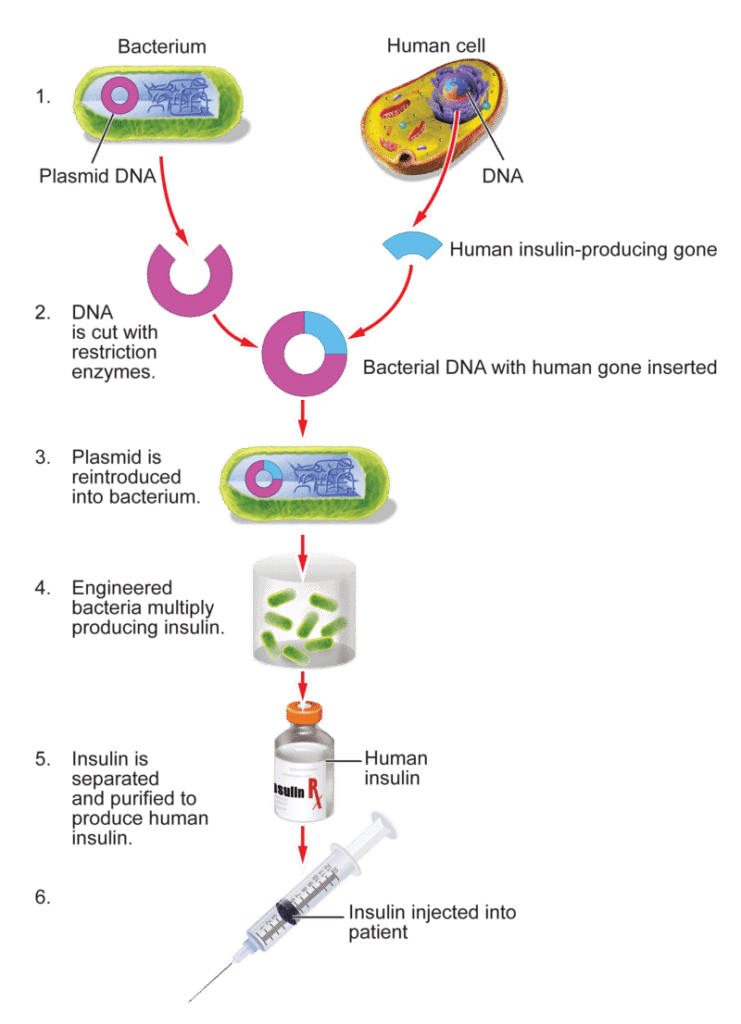Introduction:
Cloning term is a quite known term to biologist. For a newbie, the cloning term might be limited to make copy of an organism and creating clones. But when we talk about Gene cloning in Molecular Biology and Genetic Engineering, it means making copies of segment of DNA or desired gene. The gene cloning can be done in live cells or in PCR.
To conduct gene cloning in live cells, the desired gene or gene of interest is inserted in a vector. We need vectors because they have origin of replication and relevant genes required for replication. The vector-carrying gene of interest is then inserted in the bacterial cell by the process of transformation. When the transformed bacteria multiply, the vector carrying desired gene also multiplies and makes its copies. For gene cloning, we need to first cut the desired gene from the host or source and then paste it in vector (plasmid). Genetic engineering tools such restriction endonuclease and ligase is used for cutting and pasting the desired gene.

Steps in Gene cloning –
Isolation of desired gene –
- Source DNA can be a whole genomic DNA of a particular organism of interest, DNA synthesized from RNA template by reverse transcriptase, a gene amplified by PCR or a totally synthesized DNA made in-vitro.
- This source DNA is to be cut with a particular Restriction enzyme to get a manageable-sized fragment of interest For example, if you wish to isolate an insulin gene from a eukaryotic cell. You need to isolate whole genome of the eukaryotic cell and spliced it using restriction enzymes. These molecular scissors will specifically cut at the restriction site (palindromic sequence) and release our gene of interest i.e. insulin gene from the whole genome.
Insertion of Gene of interest into a vector –
- Cloning vectors acts like carriers that carry our gene of interest.
- The cloning vectors are small; independently replicating genetic elements used to replicate genes and is derived from plasmids or viruses.
- They are typically designed to allow in-vitro insertion of our gene of interest (in our example – insulin) at a restriction site. The restriction site of vector is cut by restriction enzyme and the gene of interest is pasted with the help of ligase enzyme forming a recombinant vector.
Bacterial Transformation –
- The recombinant vector is introduced into the bacteria by transformation. The bacteria naturally exhibit the ability to uptake the naked DNA such bacterial cells are called as competent cells. This DNA uptake ability is exploited in Gene cloning experiments.
- In vitro, to conduct bacterial transformation successful, the bacterial cells are either given heat shock or treated with organic solvent such as DMSO or PEG. In the heat shock treatment, the high voltage current causes the formation of small pores in the bacterial membrane through which the vector can enter.
Selection of Transformed cells-
- In the transformation step, not all the bacterial cells are able to uptake the vector and hence we need to differentiate between transformed and non-transformed cells.
- The selected vector has an antibiotic resistant gene (ex. ampicillin resistant), which is be used as a marker.
- After the transformation step, the bacteria are inoculated on media containing ampicillin.
- The bacteria, which are transformed with vector carrying our desired gene and ampicillin, will only be able to survive on this selective media.
Production of desired protein-
- The transformed cells acts like micro factories that can produce the desired gene. In this example, we have inserted the insulin gene.
- The bacteria transcribe and translate our desired gene and produce insulin.
- The insulin can be extracted and purified by splitting or breaking the cell.

Advantages and Applications:
- It is used for production of proteins and enzymes.
- It is used for producing recombinant pharmaceutical important biomolecule.
- It is used for the production of vaccines , antibiotics, vitamins and growth hormones.
- The Gene cloning can be applied for genetically modifying crops and livestock for better yield.
Limitations:
- Gene cloning may have high chances of mutations occurring in genetic level hence leading in malfunctioning of cells, can also lead in creation of new, aggressive and pathogenic variants of organisms.
- It decreases gene diversity of an host organism i.e. introduction of a new gene into genome of host organism may lead to the loss of original genes of the respected host.
References:
https://www.clear.rice.edu/bioc111/bios111_transformation.htm
https://di.uq.edu.au/community-and-alumni/sparq-ed/sparq-ed-services/dna-ligation



One thought on “An Introduction to Gene Cloning for a Newbie”